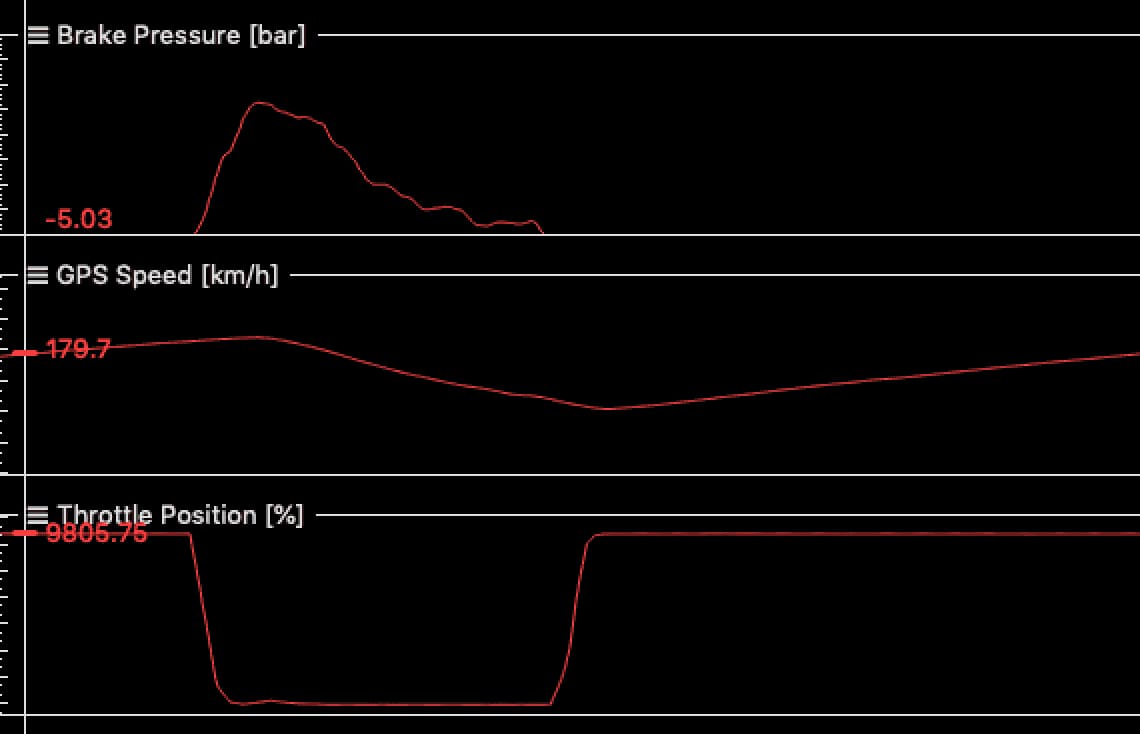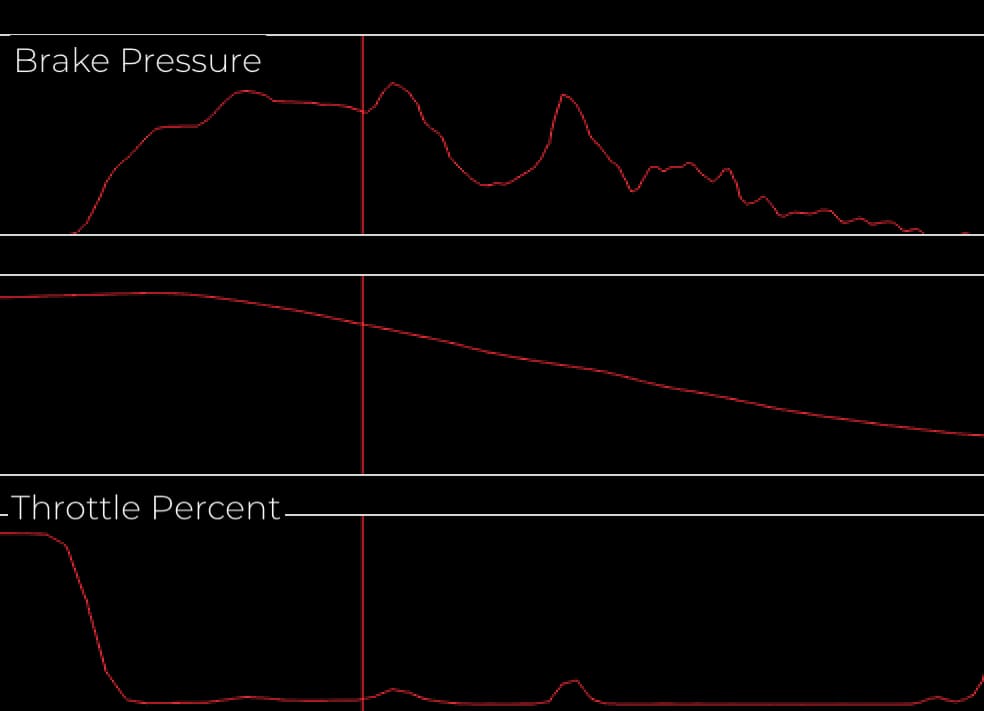How to Easily Master the Skill of Rev Matching – A Quick Guide on Why Rev Matching is Important to Your Lap Speed
Before drivers are ready to work on rolling entry speed and
trail braking into a corner there are a few foundations that must first be perfected. One of these foundations is timing the downshifts within the braking zone and perfecting rev matching. It does not matter if you are having to heel toe downshift or if you are driving a paddle shift car, forming this foundation is important for drivers of all levels!
Timing The Downshifts
Blayze Pro-Racing Coach,
Dion von Moltke, states that the first step of perfecting downshifts on the race track is identifying where in the brake zone they should come. Braking zones can be split into three zones:
1. Initial brake application (the shortest part of the braking zone)
2. The slow release of brake pressure in a straight line (the longest part of the braking zone)
3. Releasing off the last bit of brake pressure after turn in
We want to avoid our downshifts coming in zone 1 or 3. Contrary to common belief we typically don’t want to heel toe downshift when we are at our absolute highest threshold braking. At that point our speed is higher which will make the rev matching more difficult for drivers. (We will get into perfecting the rev matching a little bit later in this article.)
Here are some graphs using data to help visualize the 3 zones in a braking zone:

Zone 1

Zone 2

Zone 3
We also want to try and avoid downshifting after the turn in point at corner entry. There are a few reasons for this. The main issue is if we don’t get that perfect rev match and we lock the rears a little bit, the negative effect of that will be made worse when we are turning in. During straight-line braking, if we don’t time the blip correctly and we don't get our rev matching perfect, the rears will lock a little bit as we release the clutch. Typically, this will just cause the rear to move around on us a little bit in straight line braking but won’t cause a spin unless it is very egregious. If we make that same mistake after turn in it will almost always cause a spin or a very big moment. After the turn in we are also on very light brake pressure and our focus needs to be fully on feeling the car at the limit and manipulating the brake pressure to work with any understeer or oversteer we may have. That extra mental capacity needed to heel toe downshift in that region will distract most drivers too much and they will tend to make more small mistakes as they get closer to driving the car on the limit.
It does not matter if you are left foot braking or right foot braking where we want our downshifts to come in the braking zone remains the same.
Rev Matching
We want our downshifts to come later in a brake zone primarily to make the rev matching much easier to do. When we time our downshift correctly and we time our blip correctly rev matching should be very easy. It should never require more than about 10% to 20% throttle on the blip. If you feel like you need more than that then you have mistimed that downshift or blip.
Let’s take a look at a drivers data and compare their braking zones when they have to downshift and when they do not have to downshift.

In this first braking zone, there is no downshift, and this graph looks picture perfect. Look at that immediate ramp-up on brake pressure and a very nice release, this is what all brake zones should look like regardless of whether there is one downshift, multiple downshifts, or none.
Now, let’s see what the same drivers braking zone looks like when they are downshifting:

What makes this even more fascinating is that our driver here is a left foot braker. So, this is not the typical incorrect
heel toe technique that leads a driver to release off of the brakes during those blips. The difference in these braking zones is all mental!
Let’s go through the key areas they need to fix.
1. First and foremost we want to see them get back to that hard initial hit of the brakes. The relative “heavy” brake pressure in brake zones will be different from corner to corner, but where the heaviest brake pressure comes in a specific brake zone should never change. The heaviest brake pressure should happen right away.
2. Crisp blips and correct timing. If you look where our driver blips the throttle you will see they are not crisp at all, this is usually a big sign of lack of confidence in one's technique and it can make the car feel worse during the downshift.
Our driver has perfect timing with their downshifts, but they let other techniques suffer too much to have a good-looking brake zone. Also, an additional note that should serve as a warning for all left foot brakers, if you look closely, you can see our driver is ever so slightly resting their right foot on the throttle during the braking zone. That is very dangerous so if you are a left foot braker make sure you take the time to check your data to ensure you are not doing this yourself. Checking for this should be a part of your post-session downloads every time.
To make rev matching easier we also need to speak about where in the heel toe downshift the blip needs to come. Far too often we see drivers engage the clutch, blip the throttle as they are taking it out of the gear they were in, and then going to the gear they want to downshift to and then release the clutch. One small change that makes the world of difference in making heel toe downshifting much easier is timing the blip better. We want to see drivers engage the clutch, take the shifter out of the gear you are in, and then as you are pushing the shifter into the gate of the gear you are downshifting into blip then and release the clutch. The first way drivers need to blip much more aggressively as the rpm’s don’t stay high for very long and that makes the whole technique much less consistent. When we delay our blip by that tiny amount, we need much less throttle percent on the blip and the entire downshift becomes much more consistent.
Why Is Rev Matching So Important?
It is impossible for a driver in a manual car to be at the limit of the car if they do not have a solid heel toe technique and are blipping the throttle to match the revs. The reason for this comes down to entry speed.
When a driver just slowly releases the clutch the rear tires will start to lock and they will need to kill off more speed to get into gear. A well-timed blip allows the driver to get the car into the gear they want at a higher speed. Since we want our downshifts to come before the turn in, that blip allows us to get the downshift done with more speed, turn in at more speed and trail brake all the way down to the apex.
When drivers do not blip they have to slow down more in a straight line and will have to turn in with less entry speed. The corner entry over slowing then often causes other very bad habits, one of those is causing a driver to pick up the throttle too early. Picking up the throttle too early is actually by far the most common error our coaches at Blayze see,
we have a great in-depth article on why it is such a problem hereTo make rev matching easier we want you to focus on a few key points:
- Downshift in the middle of the braking zone
- Time your blip as you are engaging the shifter into the gear you are downshifting into
- Crisp blips but we don’t need much throttle
By focusing in on these three core areas it can give you something to focus in on, which helps drivers learn. A lot is going on in a heel toe downshift braking zone, so if we can limit all the noise and focus in on key areas, we can make the entire technique feel a lot simpler.
Make sure you also check out our links in this article for the perfect heel toe technique where we go much more in-depth on that specific technique!
Learn More With Blaze!
The secret to mastering any skill is practice! Are you looking to start your racing journey? Could you use direct feedback from a professional coach on how to improve your racing and motorsport skills?
At Blayze we give you a personalized coaching session from the very best coaches in the world. For a truly unique and personalized feedback experience, submit your performance video to one of Blayze’s highly qualified coaches. The custom-developed coaching session can help you improve your on-track, so you are performing at your very best in every race. One easy
click here will take you to more details on our coaching sessions.






